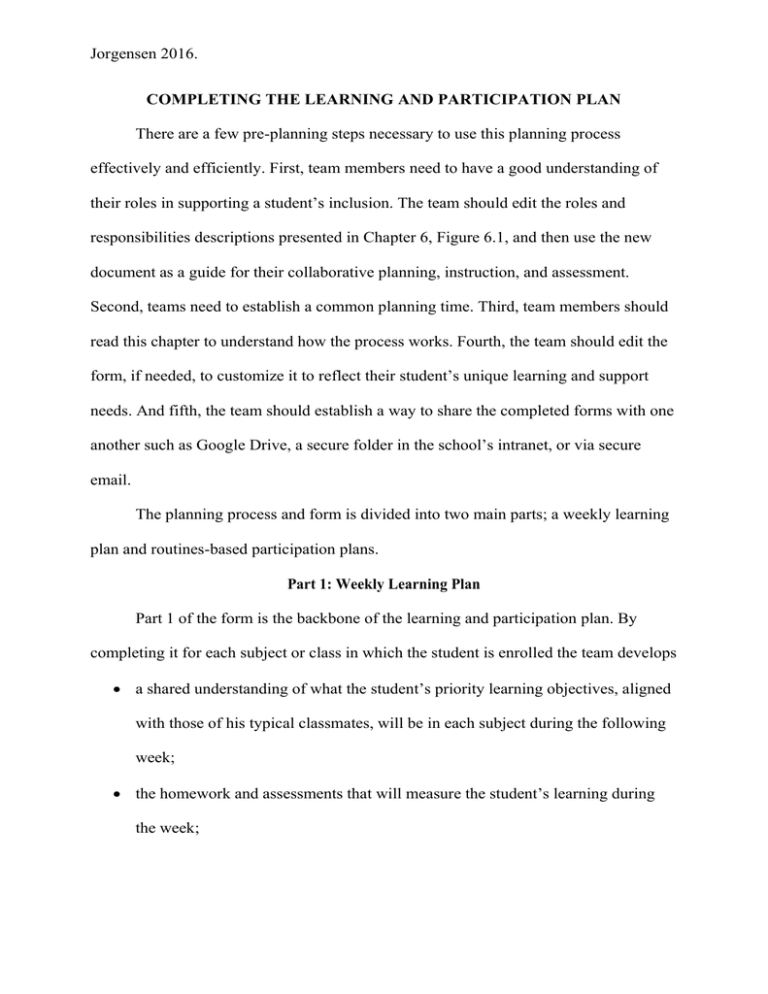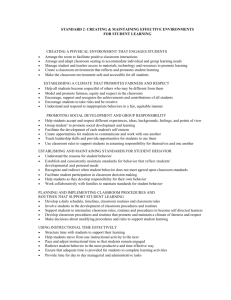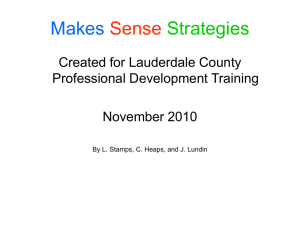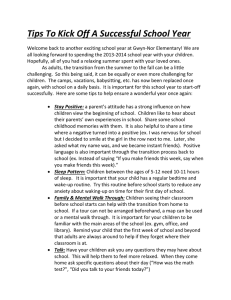Jorgensen 2016.
advertisement

Jorgensen 2016. COMPLETING THE LEARNING AND PARTICIPATION PLAN There are a few pre-planning steps necessary to use this planning process effectively and efficiently. First, team members need to have a good understanding of their roles in supporting a student’s inclusion. The team should edit the roles and responsibilities descriptions presented in Chapter 6, Figure 6.1, and then use the new document as a guide for their collaborative planning, instruction, and assessment. Second, teams need to establish a common planning time. Third, team members should read this chapter to understand how the process works. Fourth, the team should edit the form, if needed, to customize it to reflect their student’s unique learning and support needs. And fifth, the team should establish a way to share the completed forms with one another such as Google Drive, a secure folder in the school’s intranet, or via secure email. The planning process and form is divided into two main parts; a weekly learning plan and routines-based participation plans. Part 1: Weekly Learning Plan Part 1 of the form is the backbone of the learning and participation plan. By completing it for each subject or class in which the student is enrolled the team develops a shared understanding of what the student’s priority learning objectives, aligned with those of his typical classmates, will be in each subject during the following week; the homework and assessments that will measure the student’s learning during the week; Jorgensen 2016. the instructional routines that the teacher will be using most frequently during the following week; vocabulary that needs to be provided through the student’s communication device and other supports; accessible instructional materials that need to be prepared; the accommodations for students with CVI that need to be provided; and team member responsibilities for preparing supports in a timely manner. Step 1: Prior to the team meeting the general education teacher should complete the following sections of Part 1 of the form: Part A: Columns 1 and 3. Part B: The instructional routines that will be used each day of the week in that subject Part D: The instructional materials, tools, and equipment that will be used by the teacher and by the typical students It will be impossible to accomplish the goals of planning if the general education teacher hasn’t filled in these sections prior to the meeting. Step 2: Identify who will type notes into the form. Open the form to the version that has been partially completed by the general education teacher. If the team uses Google Drive all team members can view the planning form as they are completing it during or outside of the meeting. Another option is for the note taker to project the form on to a screen via an LCD projector. Step 3: Fill in the top portion of the form including the student’s name, subject area, unit (if appropriate), and the dates for which the team is planning. Part A: Learning Objectives and Assessments Jorgensen 2016. Step 4: Determine what the focus student’s learning objectives will be in this subject for the week. Enter these in column 2. These learning objectives should reflect learning objectives from the general education curriculum and may reflect annual goals or objectives from the student’s IEP. If the student is participating in the state’s general assessment (with or without accommodations) and striving to get credit that will count toward receipt of a regular high school diploma, her learning objectives should be the same as those of the other students in the class. If the student participates in the state’s alternate assessment or is not trying to get a regular high school diploma, these learning objectives can be modified or taken from the state’s alternate achievement standards. Step 5: Describe how the student’s achievement towards his learning objectives will be evaluated and what homework she’ll be assigned. Enter this information in column 4 along with the initials of the team member responsible for making homework and assessment adaptations. Part B: Instructional Routines Step 6: In the next section of Part 1, review the instructional routines that will be used by the teacher each day of the week. Knowing what instructional routines will be used will help the team determine what routines need to be planned for using Part 2 of this form. During the meeting it may be helpful for the general education teacher to provide additional information about each day’s lessons. These details are typed into the form just below Part B. Instructional Routines. Part C. Vocabulary for Augmentative Communication Step 7: If the student has AAC needs, this part of the form guides the team to make decisions about how best to provide the student with vocabulary for communication Jorgensen 2016. during the following week’s lessons. If the student does not have AAC needs, you can simply delete this section of the form for this student or leave it blank. Put the initials of the team member responsible for programming the AAC device or creating light-tech communication materials next to each entry. Part D. Accessible Instructional Materials Step 8. Virtually all students with intensive support needs need to have the regular classroom materials made accessible through individualized adaptations. Most IEP forms have a check box that says, in effect, “The student needs accessible instructional materials” and “The student needs assistive technology.” Based on the information that the general education teacher has provided about what instructional materials will be used with the class (row 1), specify the adaptations that will be made to assure accessibility for the focus student (row 2). Put the initials of the team member responsible for finding or creating these accessible materials next to each entry. Part E. Cortical Visual Impairment Supports The supports needs by students with cortical visual impairment (CVI) are more extensive than those needed by students with other vision-related disabilities. Step 9: Under the leadership of the Teacher of the Visually Impaired (TVI), record the supports needed by the student in each CVI characteristic area with the initial of the team member responsible. Part 2: Participation Support Plan for Routines Instructional routines are defined by the configurations of the students, the teaching practices of the teacher, and the behaviors of the students that show they are engaged in learning. Common routines in core academic classes include: Jorgensen 2016. teacher-led whole class instruction teacher-led whole class discussion students working in small groups on a common task students having small group discussions students working independently at their desks laboratory experiments student presentations of their work There are other routines that are common in physical education, the arts, and electives such as: team-based games and sports – throwing, catching, and hitting balls individual games and sports – running, swimming, hitting balls warm up activities – running laps, doing calisthenics cooking – cutting, measuring ingredients, stirring making art – drawing, painting, sculpting singing and acting planting The benefit of creating support plans for the most common routines in which the focus student is engaged is that once the support plan is finished, it will serve the student for the entire year, as long as the routine remains relatively the same (Jorgensen, McSheehan, & Sonnenmeier, 2010). For example, if students in kindergarten participate in calendar time every day, then the supports for the focus student’s engagement will be virtually the same whether the calendar activity is done in September or June. If students write on a computer every day, the supports for the student’s writing will be the Jorgensen 2016. same except perhaps for the vocabulary that the student is required to use. Planning for routines will save time for the team so that they do not have to plan for the same activity over and over again. I recommend that the student’s special education teacher or inclusion facilitator (IF) begin the process of completing the relevant instructional routines participation plans and then gather input from other team members by using a part of the team’s weekly planning meeting time or by having the SLP, OT, PT, or other team members add to a Google Drive document. The first step for each routine is to ask the general education teacher (or observe in the classroom) to identify the behaviors of the students that indicate they are fully engaged in the routine. Once the team has determined the routines that the focus student will be engaged in, they can customize the plan as needed by simply editing the plan. Follow these steps to complete an instructional routine participation plan. Step 1: Enter the name of the routine in the heading of the form, the student’s name, and subject area (if it is a subject-specific routine such as cooking, science, etc.). Many routines are common to all subject areas and that is one benefit of developing routinesbased participation plans. Step 2: Using brief bullet points, enter into column 1 what students without disabilities do in order to participate in the instructional routine. Do not describe what the teacher is doing as she teaches, but rather what an observer might see students doing to indicate they are fully engaged in instruction. Step 3: Enter into the relevant columns the supports that the focus student needs in order to participate in a way that is commensurate with the participation of her Jorgensen 2016. classmates without disabilities. These supports columns should be customized to meet your student’s priority support needs. For example, some students do not need sensory supports, but may need physical supports. These supports should be the same as those on the student’s IEP in the section on supplementary aids and services or accommodations and modifications. Sometimes teams find that as they complete a few routines participation forms they discover additional items to add to those sections of the student’s IEP by writing an amendment or the next time the IEP is renewed.



